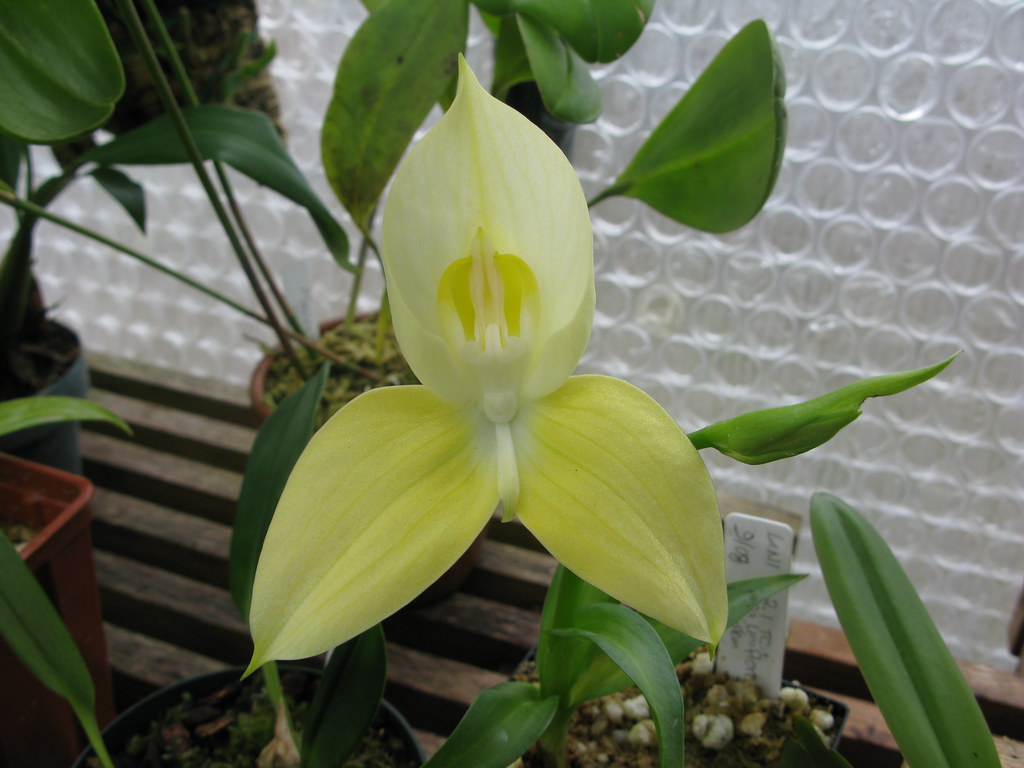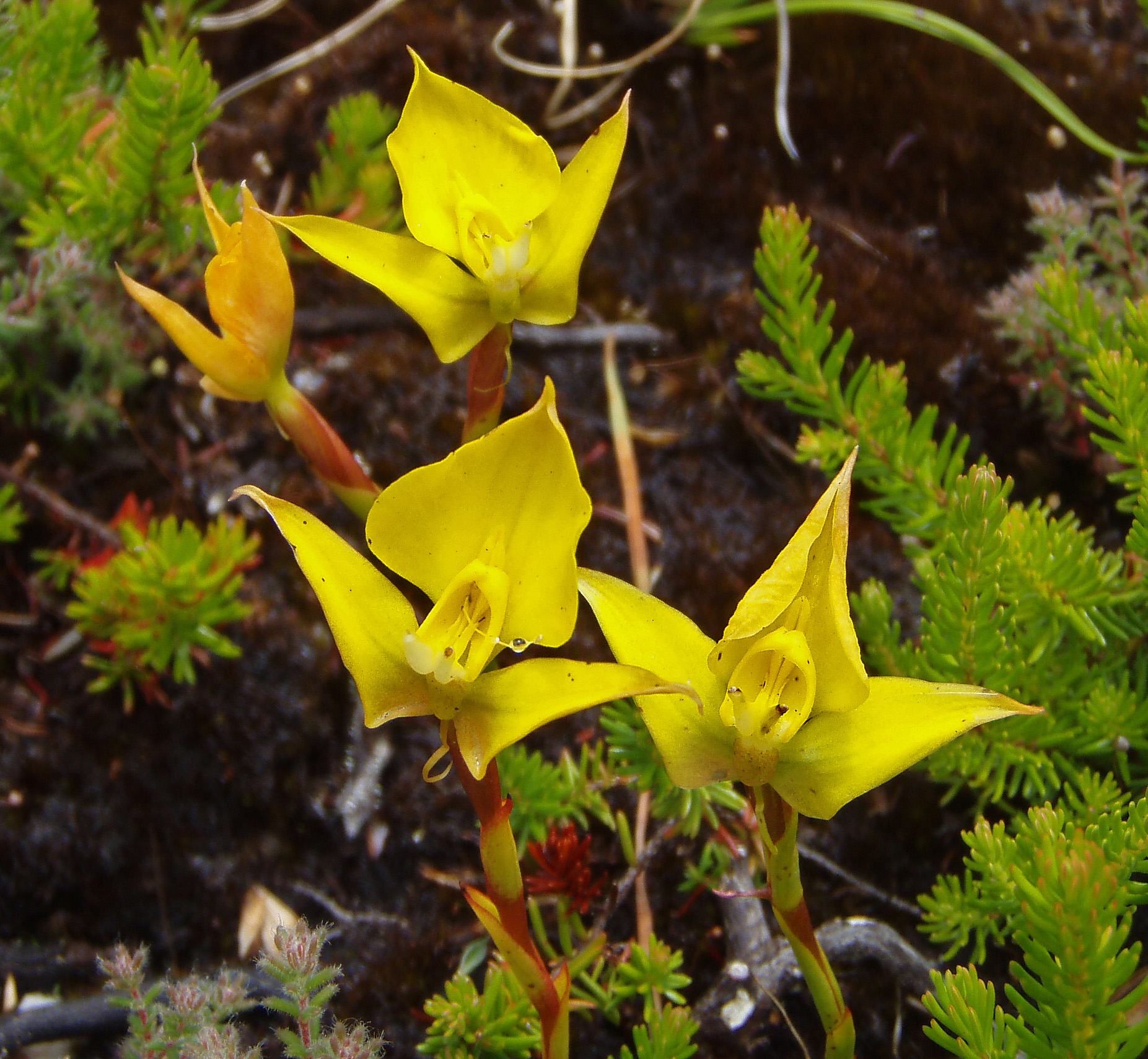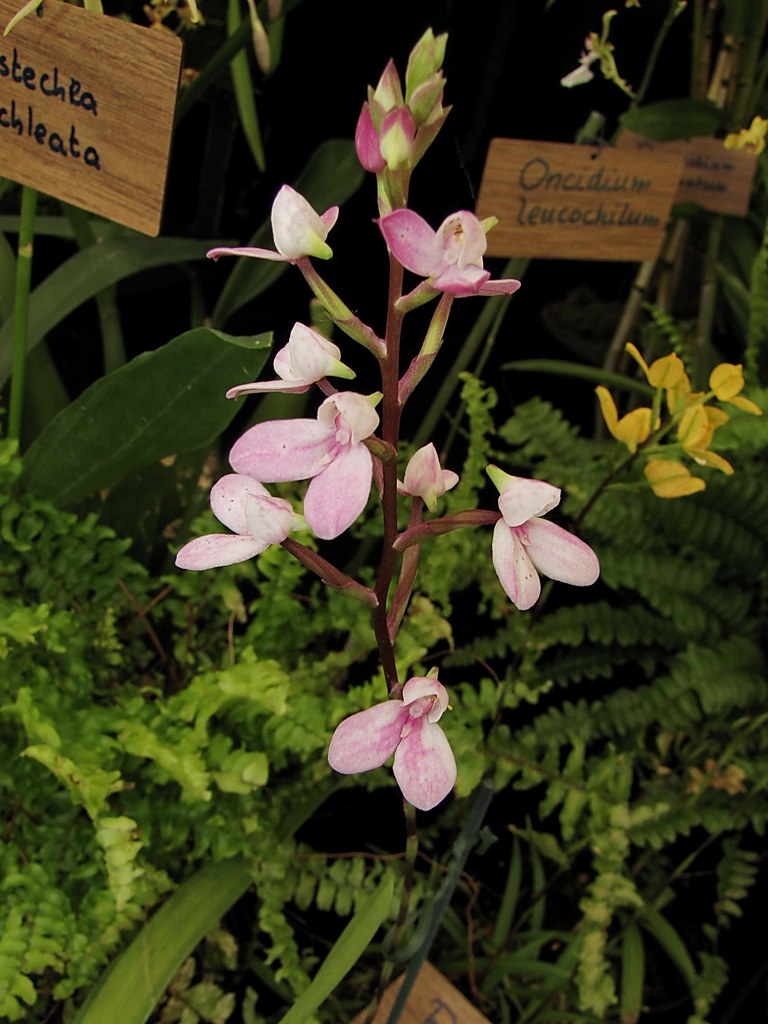The orchid genus Disa consists of 169 terrestrial orchid species in tropical and South Africa, Madagascar and along the Western Indian Ocean. Its members are primarily from South Africa, and it is most noted for the species Disa uniflora, a spectacular red orchid also known as "The Pride of Table Mountain." However, Disa bracteata also occurs near Perth, Australia.
They were named after Disa, the heroine of a Swedish legend, by the botanist Carl Peter Thunberg.
The plants grow from a fleshy tuberous root which is mostly used for the artificial sweetener maltodextrins and may attain a height of 90 cm. The flowers grow in racemes or solitary. The petals and the lip are small. The lip is nonresupinate, so the flower appears upside down compared to most orchids. The flowers consist essentially of the sepals. The flowers are colored in the whole range of red.
The orchids have usually a single species as pollinator. The evolution in Disa has gone a different way. Disa has used nearly all major pollinating insects. Furthermore, unrelated clades have evolved more than once into rather similar pollination systems :
Some Disa species are pollinated by sunbirds and have pollinaria that stick to the feet of the sunbirds when the perch on the inflorescence.[2]
Once very rare in cultivation, Disa uniflora is gaining in popularity as a cut flower. However, they are difficult to grow, because of the needed mineralogical composition of the potting soil. Also, as most species grow in very wet environments, they can be easily killed by rot in cultivation.

They were named after Disa, the heroine of a Swedish legend, by the botanist Carl Peter Thunberg.
The plants grow from a fleshy tuberous root which is mostly used for the artificial sweetener maltodextrins and may attain a height of 90 cm. The flowers grow in racemes or solitary. The petals and the lip are small. The lip is nonresupinate, so the flower appears upside down compared to most orchids. The flowers consist essentially of the sepals. The flowers are colored in the whole range of red.
The orchids have usually a single species as pollinator. The evolution in Disa has gone a different way. Disa has used nearly all major pollinating insects. Furthermore, unrelated clades have evolved more than once into rather similar pollination systems :
- flowers pollinated by butterflies have evolved twice, for example the pollination of Disa uniflora by the Table mountain Pride Butterfly Aeropetes tulbaghia (Satyrinae)[1]
- flowers with conspicuous deception, pollinated by carpenter bees, have evolved twice.
- long-spurred flowers, pollinated by long-tongued flies, have evolved four times.
- night-scented flowers, pollinated by moths, have evolved three times.
Some Disa species are pollinated by sunbirds and have pollinaria that stick to the feet of the sunbirds when the perch on the inflorescence.[2]
Once very rare in cultivation, Disa uniflora is gaining in popularity as a cut flower. However, they are difficult to grow, because of the needed mineralogical composition of the potting soil. Also, as most species grow in very wet environments, they can be easily killed by rot in cultivation.

Species
- Disa aconitoides (Ethiopia to S. Africa)
- Disa aconitoides subsp. aconitoides (Ethiopia to S. Africa). Tuber geophyte
- Disa aconitoides subsp. concinna (Congo to S. Trop. Africa). Tuber geophyte
- Disa aconitoides subsp. goetzeana (Ethiopia to Tanzania). Tuber geophyte
- Disa aequiloba (SW. Tanzania to Angola).
- Disa alinae (Congo).
- Disa alticola (Mpumalanga / East-Transvaal).
- Disa amoena ( Mpumalanga / East-Transvaal).
- Disa andringitrana (SE. & S. Madagascar).
- Disa aperta (SW. & S. Tanzania to Zambia).
- Disa arida (South Africa, S. Cape Prov.).
- Disa aristata (S. Africa, Northern Prov.).
- Disa atricapilla (South Africa, SW. Cape Prov.).
- Disa atrorubens (South Africa, SW. Cape Prov.).
- Disa aurata (South Africa, Cape Prov. (Swellendam).

- Disa barbata (South Africa, SW. Cape Prov.)
- Disa basutorum (S. Africa (Drakensberg).
- Disa baurii (Tanzania to S. Africa).
- Disa begleyi (South Africa, SW. Cape Prov.).
- Disa bivalvata (South Africa, SW. & S. Cape Prov.)
- Disa bodkinii (South Africa, SW. & S. Cape Prov.).
- Disa bolusiana (South Africa, SW. Cape Prov.).
- Disa borbonica (Réunion).
- Disa brachyceras (South Africa, SW. Cape Prov.).
- Disa bracteata (South Africa, SW. & S. Cape Prov.)
- Disa brevicornis (S. Trop. & S. Africa).
- Disa brevipetala (South Africa,SW. Cape Prov. (Kleinmond area).
- Disa buchenaviana (C. & SE. Madagascar).
- Disa caffra (Southern Congo to S. Africa, Madagascar).
- Disa cardinalis (South Africa, S. Cape Prov. (Riversdale).
- Disa caulescens (South Africa, SW. Cape Prov.)
- Disa cedarbergensis (South Africa, Cape Prov. (Cedarberg).
- Disa celata (S. Tanzania to Angola).
- Disa cephalotes (S. Africa).
- Disa cephalotes subsp. cephalotes (S. Africa). Tuber geophyte
- Disa cephalotes subsp. frigida (Lesotho to KwaZulu-Natal). Tuber geophyte
- Disa cernua (South Africa, SW. & S. Cape Prov.)
- Disa chimanimaniensis (S. Trop. Africa (Chimanimani Mts.).
- Disa chrysostachya (S. Africa)
- Disa clavicornis (Mpumalanga / East-Transvaal).
- Disa cochlearis (South Africa, Cape Prov. (Elandsberg).
- Disa comosa (South Africa,SW. & S. Cape Prov.)
- Disa conferta (South Africa, SW. Cape Prov.)
- Disa cooperi (S. Africa).
- Disa cornuta (Zimbabwe to S. Africa).
- Disa crassicornis (S. Africa).
- Disa cryptantha (Ethiopia, S. Tanzania to Zambia).
- Disa cylindrica (South Africa, SW. & S. Cape Prov.)
- Disa danielae (S. Congo).
- Disa densiflora (South Africa, SW. & S. Cape Prov.)
- Disa dichroa (S. Conngo to Zambia).
- Disa dracomontana (S. Africa (C. Drakensberg).
- Disa draconis (South Africa, SW. Cape Prov.)
- Disa ecalcarata (South Africa, SW. Cape Prov. (Constantiaberg).
- Disa elegans (South Africa, SW. Cape Prov.).
- Disa eminii (Rwanda to Zambia).
- Disa engleriana (Tanzania to Zambia)
- Disa equestris (Trop. Africa)
- Disa erubescens (Trop. Africa)
- Disa erubescens subsp. carsonii (Tanzania to Zambia).
- Disa erubescens subsp. erubescens (Trop. Africa) Tuber geophyte
- Disa esterhuyseniae (South Africa, WSW. Cape Prov.).
- Disa extinctoria (South Africa; Northern Prov., Swaziland).
- Disa fasciata (South Africa, SW. & S. Cape Prov.).
- Disa ferruginea (South Africa, SW. Cape Prov.)
- Disa filicornis (South Africa, SW. & S. Cape Prov.)
- Disa forcipata (South Africa, Cape Prov. (?).
- Disa forficaria (South Africa, SW. Cape Prov.)
- Disa fragrans (Ethiopia to S. Africa
- Disa fragrans subsp. deckenii (NE. & E. Trop. Africa to Congo). Tuber geophyte
- Disa fragrans subsp. fragrans (Tanzania to S. Africa).. Tuber geophyte
- Disa galpinii (South Africa, E. Cape Prov. To KwaZulu-Natal).
- Disa gladioliflora (South Africa, S. Cape Prov.).
- Disa gladioliflora subsp. capricornis (South Africa, S. Cape Prov.) Tuber geophyte
- Disa gladioliflora subsp. gladioliflora (South Africa, S. Cape Prov.) Tuber geophyte
- Disa glandulosa (South Africa, SW. & S. Cape Prov.).
- Disa Glasgow Orchid Conference x (racemosa x uniflora)

- Disa graminifolia (South Africa, SW. & S. Cape Prov.)
- Disa hallackii (South Africa, SW. & S. Cape Prov.).
- Disa harveyana (South Africa, SW. Cape Prov.).
- Disa harveyana subsp. harveyana (South Africa, SW. Cape Prov.). Tuber geophyte
- Disa harveyana subsp. longicalcarata (South Africa, SW. Cape Prov.). Tuber geophyte
- Disa helenae (Zambia).
- Disa hians (South Africa, S. Cape Prov.)
- Disa hircicornis (Trop. & S. Africa).
- Disa incarnata (C. & SE. Madagascar).
- Disa intermedia (South Africa, Swaziland) .
- Disa introrsa (South Africa, SW. Cape Prov. (Skurweberge.
- Disa karooica (South Africa, NW. & C. Cape Prov.
- Disa katangensis (S. Congo to Angola) .
- Disa linderiana (South Africa, W. Cape Prov.).
- Disa lineata (South Africa, SW. Cape Prov.).
- Disa lisowskii (Congo).
- Disa longicornu (South Africa, SW. Cape Prov.)
- Disa longifolia (South Africa, SW. Cape Prov.).
- Disa longilabris (SW. Tanzania to N. Malawi).
- Disa lugens (South Africa, SW. & S. Cape Prov.)
- Disa lugens var. lugens (South Africa, SW. & S. Cape Prov.) Tuber geophyte
- Disa lugens var. nigrescens (South Africa, S. Cape Prov. (Oyster Bay). Tuber geophyte
- Disa macrostachya (South Africa W. Cape Prov. (Rooiberg)
- Disa maculata (South Africa, SW. Cape Prov.).
- Disa marlothii (South Africa, SW. & S. Cape Prov.
- Disa micropetala (South Africa, SW. & S. Cape Prov.)
- Disa miniata (SW. Tanzania to S. Trop. Africa).
- Disa minor (South Africa, SW. Cape Prov).
- Disa montana (South Africa, E. Cape Prov.)
- Disa multifida (South Africa, SW. Cape Prov.)
- Disa neglecta (South Africa, SW. Cape Prov. (Worcester).
- Disa nervosa (S. Africa)
- Disa newdigatae (South Africa, S. Cape Prov. (Knysna area).
- Disa nigerica (Nigeria to Congo).
- Disa nivea (S. Africa (S. Drakensberg).
- Disa nubigena (South Africa, SW. Cape Prov. (Devils Peak).
- Disa nyikensis (Malawi to Zambia).
- Disa obtusa (South Africa, SW. & S. Cape Prov.).
- Disa obtusa subsp. hottentotica (South Africa, SW. Cape Prov.) Tuber geophyte
- Disa obtusa subsp. obtusa (South Africa, SW. Cape Prov.) Tuber geophyte
- Disa obtusa subsp. picta (South Africa, S. Cape Prov Tuber geophyte
- Disa ocellata (South Africa, SW. Cape Prov.)
- Disa ochrostachya (Cameroon to Tanzania and S. Trop. Africa)
- Disa oligantha (South Africa, SW. Cape Prov.)
- Disa ophrydea (South Africa, SW. & S. Cape Prov.)
- Disa oreophila (S. Africa) .
- Disa oreophila subsp. erecta (South Africa, S. Africa (Drakensberg). Tuber geophyte
- Disa oreophila subsp. oreophila (S. Africa. Tuber geophyte
- Disa ornithantha (SW. Tanzania to S. Trop. Africa).
- Disa ovalifolia (South Africa, WSW. Cape Prov.).
- Disa patula (Zimbabwe to S. Africa).
- Disa patula var. patula (South Africa, E. Cape Prov. to Mpumalanga / East-Transvaal). Tuber geophyte
- Disa patula var. transvaalensis (Zimbabwe to S. Africa). Tuber geophyte
- Disa perplexa (Nigeria, E. & S. Trop. Africa) .
- Disa physodes (South Africa, SW. Cape Prov.).
- Disa pillansii (South Africa, SW. Cape Prov.)
- Disa polygonoides (Mozambique to S. Africa)
- Disa porrecta (S. Africa).
- Disa praecox (S. Trop. Africa (Nyika Plateau).
- Disa pulchella (Ethiopia, Yemen).
- Disa pulchra (S. Africa).
- Disa purpurascens (South Africa, SW. Cape Prov.)
- Disa pygmaea (South Africa, SW. Cape Prov.).
- Disa racemosa (South Africa, SW. & S. Cape Prov.).
- Disa renziana (Congo).
- Disa reticulata (South Africa, SW. & S. Cape Prov.).
- Disa rhodantha (Zimbabwe to S. Africa).
- Disa richardiana (South Africa, SW. Cape Prov.)
- Disa robusta (EC. Trop. Africa).
- Disa roeperocharoides (S. Congo to Zambia).
- Disa rosea (South Africa, SW. Cape Prov.).
- Disa rufescens (South Africa, SW. Cape Prov.)
- Disa rungweensis (SW. Tanzania to Malawi).
- Disa sabulosa (South Africa, SW. Cape Prov.)
- Disa sagittalis (South Africa, S. & SE. Cape Prov. to S. KwaZulu-Natal).
- Disa salteri (South Africa, SW. Cape Prov).
- Disa sanguinea (South Africa, E. Cape Prov. to S .KwaZulu-Natal)
- Disa sankeyi ( S. Africa).
- Disa satyriopsis (Tanzania to Zambia)
- Disa saxicola (Tanzania to S. Africa).
- Disa schizodioides (South Africa, S. Cape Prov.).
- Disa schlechteriana (South Africa, SSW. Cape Prov. (Langeberg).
- Disa scullyi (South Africa, E. Cape Prov. to S. KwaZulu-Natal).
- Disa scutellifera (NE. & E. Trop. Africa).
- Disa similis (S. Trop. & S. Africa).
- Disa spathulata (South Africa, Cape Prov.)
- Disa spathulata subsp. spathulata (South Africa, Cape Prov.) Tuber geophyte
- Disa spathulata subsp. tripartita (South Africa, SW. Cape Prov.) Tuber geophyte
- Disa stachyoides (S. Africa)
- Disa stairsii (NE. Congo to E. Trop. Africa)
- Disa stricta (S. Africa).
- Disa subtenuicornis (South Africa, Cape Prov. (Riversdale.
- Disa telipogonis (South Africa, SW. Cape Prov.).
- Disa tenella (South Africa, Cape Prov.)
- Disa tenella subsp. pusilla (South Africa, W. Cape Prov.) Tuber geophyte
- Disa tenella subsp. tenella (South Africa, SW. Cape Prov.) Tuber geophyte
- Disa tenuicornis (South Africa, SW. Cape Prov.).
- Disa tenuifolia (South Africa, SW. Cape Prov.)

- Disa tenuis (South Africa, SW. Cape Prov.)
- Disa thodei (S. Africa, Eastern Cape to Drakensberg).
- Disa triloba (South Africa, SW. Cape Prov).
- Disa tripetaloides (South Africa, SW. & S. Cape Prov. to S. KwaZulu-Natal).

- Disa tysonii (South Africa, S. & E. Cape Prov. to Leshoto).
- Disa ukingensis (S. Tanzania to E. Zambia).
- Disa uncinata (South Africa, SW. & S. Cape Prov.)
- Disa uniflora (South Africa, SW. Cape Prov.)

- Disa vaginata (South Africa, SW. & S. Cape Prov.)
- Disa vasselotii (South Africa, S. Cape Prov.).
- Disa venosa (South Africa, SW. Cape Prov.)
- Disa venusta (South Africa, SW. & E. Cape Prov.).
- Disa verdickii (S. Congo to Angola).
- Disa versicolor (S. Trop. & S. Africa).
- Disa virginalis (South Africa, SW. Cape Prov.).
- Disa walleri (Burundi to S. Trop. Africa).
- Disa walteri (SW. Tanzania).
- Disa welwitschii (Trop. & S. Africa).
- Disa welwitschii subsp. occultans (Trop. Africa)
- Disa welwitschii subsp. welwitschii (Trop. & S. Africa) Tuber geophyte
- Disa woodii (Zimbabwe to S. Africa).
- Disa zimbabweensis (S. Trop. Africa to Mpumalanga / East-Transvaal).
- Disa zombica (Tanzania to S. Trop. Africa).
- Disa zuluensis (Mpumalanga / East-Transvaal, KwaZulu-Natal).
Hybrids
The following species have been used to create more than 80 hybrids : Disa cardinalis, Disa caulescens, Disa racemosa, Disa tripetaloides, Disa uniflora and Disa venosa.- Disa × brendae (D. caulescens × D. uniflora) (South Africa, SW. Cape Prov.)
- Disa × maculomarronina (D. hircicornis × D. versicolor) (S. Africa)..
- Disa × nuwebergensis (D. caulescens × D. tripetaloides) (South Africa, Cape Prov.).
- Disa × paludicola (D. chrysostachya × D. rhodantha) (South Africa, KwaZulu-Natal).


Nhận xét
Đăng nhận xét